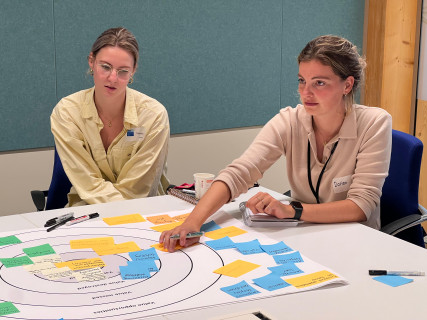CIRCOLLAB, a network in the Metropolitan Region of Amsterdam aimed at accelerating the circular transition, is developing a method to apply systems thinking and eco-centric approaches in organisations. While developing the right workshop methods, they are hosting meet-ups to discover what it takes for organisations to look beyond their organisational boundaries and feel part of the larger system. In this worksession, our Demoday participants were invited to apply value chain- and systems thinking within a Almere Pampus case, and articulate their feedback on the workshop methods.
The case of Almere Pampus
The development of Pampus is a great example to use for experiments on circular value systems as there is a fresh clean sheet to start off with. Pampus can be used as a showcase and be a leading international example for sustainable area development by designing the area in a circular, climate-adaptive, nature-inclusive and energy-neutral way from the start, and by investing in necessary and smart above- and underground systems for energy, water, soil, food and waste early on. The two themes used during this exercise were the use of biobased building materials from hemp, and a transport system for local groceries.
Value Mapping
After an introduction by Melanie de Vries (Windesheim), Quirine Winkler (Windesheim) and Darina Huinck (HvA), the participants were split into two groups, each with their own Pampus Eiland topic. We were invited to make use of a ‘Value Mapping tool for sustainable business modelling (Bocken et al., 2012) to explore the value chain for our case. After the identification of the case its ‘purpose’, there were a few steps to walk through with the group and enrich the blank canvas:
- First of all, we identified some ‘values created’, in line with the purpose of the case. Think of; financial profits, healthier living conditions, sustainable building materials etc.
- Secondly, we identified all stakeholders concerned with the value chain. They could either be connected to the case because of their influence or because they’re affected by it. Think of; businesses, societal actors, nature, policy etc.
- Realizing the goal of the chain also has its negative side effects. Think of; the need for new knowledge and training, the abandonment of efficient production chains etc.
- The final two steps involved identifying the missed values and (the related) value opportunities. The group of stakeholders related to the value network could take on these value opportunities if they work together. For example; the need for new knowledge and training could create opportunities for new education business models, and; if the creating of new building materials requires more technical educated producers, they could be rewarded with discounts or financial help on housing in these newly created neighbourhoods.
- When all steps have been completed, you can actually look back at your input on the value map and make some adjustments if necessary. The initial purpose of the value chain for example, could be different now that all types of values and stakeholders have been identified.
Insights
Collaborating on an innovation case with the help of such methodology, made the participants aware of the complexities when considering a complete (eco)system. It emphasised the importance of considering the system and its stakeholders, and the variety of (surprising) ways in which value can be created within its network.
Identifying the ‘values destroyed’ and taking on the ‘value opportunities’ would be of importance in real-life scenarios. But who should be responsible for what? This made the group aware of the importance of independent- and network organizations to make networks and systems flourish.
During this exercise the groups were randomized. However, it became clear that each individual has their own expertise and interests and therefore has a personal perception or view of the system its analysing. The variety of values and stakeholders you could identify seem endless, and your personal perspective will determine what you focus on. It is therefore important to determine the composition of the group with which you will shape such a value map.
And last but not least, Melanie, Quirine and Darina received feedback on this workshop from the participants. They will use this feedback to further develop this method and workshop, before they invite regional parties to take part in their Learning Network Circular Collaboration.
Would you like to know more about CIRCOLLAB or their Systems / Value Mapping workshops? Get in contact with Melanie (m.h.devries@windesheim.nl) or CIRCOLLAB (circollab@hva.nl). Are you working at -or with- one of our partner organisations and would you like to organise a worksession at one of our Demodays? Get in touch with me! pelle@amsterdamsmartcity.com





